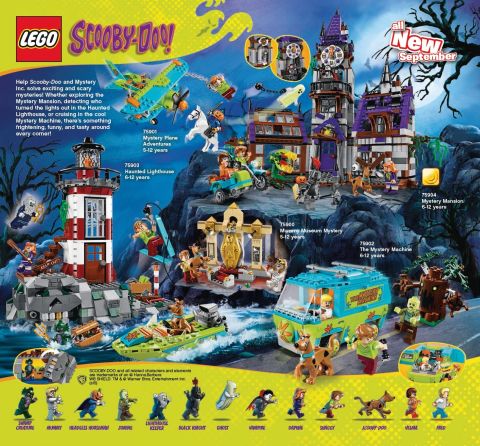The Australian version of the 2015 LEGO Summer Catalog is now available online and it lists all of the currently available sets as well as many of the sets that will be coming out in the near future. You can view and download the catalog here: 2015 LEGO SUMMER CATALOG, and below I will list some of the highlights so we can discuss. 🙂

➡ 2015 LEGO SCOOBY-DOO SETS: The LEGO Scooby-Doo website is now up and running (see here). It only includes a teaser-image at this point and the caption “We got a mystery to solve!” and that updates and the news sets will be coming in August. In the meantime the catalog has this nice spread of all of the upcoming sets.

➡ 2015 LEGO NINJAGO SETS: As we already know, LEGO Ninjago is getting a large wave of sets in August, along with flying spinners. The catalog has several pages dedicated to the theme.

➡ 2015 LEGO STAR WARS SETS: Although LEGO is very careful keeping the upcoming Star Wars: The Force Awakens sets under wraps until September, they did include a teaser-image in the catalog, along with a nice spread of the LEGO Star Wars Buildable Figures.

➡ 2015 LEGO SUPER HEROES SETS: The LEGO Super Heroes section of the catalog includes the #76035 LEGO Super Heroes Jokerland set we have heard so much about from the toy fairs earlier this year.

➡ 2015 LEGO BIONICLE SETS: The summer LEGO BIONICLE sets are also listed with skinny skeleton looking characters that can also be combined.

➡ 2015 LEGO TECHNIC SETS: LEGO Technic is getting some very impressive sets this summer, including the #42043 LEGO Technic Mercedes-Benz Arocs 3245 and the #42042 LEGO Technic Crawler Crane.

➡ 2015 LEGO FRIEND SETS: The theme for LEGO Friends this summer is pop stars. “Come join the Friends as they meet their Pop Star idol Livi! Help record her new song at the Recording Studio, style her in the Dressing Room before cheering for her on the Show Stage, then join Livi at the after party on her Popstar Tour Bus! Together with your Friends, you are the star!” And there is also the epic #41101 LEGO Friends Hearlake Grand Hotel so many people are looking forward to.

There are many other 2015 LEGO sets listed in the LEGO Summer Catalog and it is a pleasure to flip through the pages. It is also a great way to plan ahead for purchases this year. Some of the sets featured in the catalog are coming later this summer and some are already out. You can find them under the What’s New section of the Online LEGO Shop.

So what do you think? Did you look through the LEGO Summer Catalog? Which LEGO sets are you looking forward to the most this summer and fall? Is there a full theme that you are planning to collect, or you are going to get a bit of each? Feel free to share your thoughts and discuss in the comment section below! 😉
And you might also like to check out the following related posts:
- June 2015 – New LEGO Sets & Promotions
- 2015 LEGO City Space Sets Review
- 2015 LEGO City Deep Sea Sets Review
- LEGO Jurassic World Sets Reviews & Details
- 2015 LEGO Elves Sets Video-Reviews
- 2015 LEGO Ultra Agents Summer Sets Review
- LEGO Star Wars Summer Sets Review
- LEGO Super Heroes Ant-Man Final Battle
- LEGO Creator Blue Power Jet Review
- LEGO City Square Review & Details













